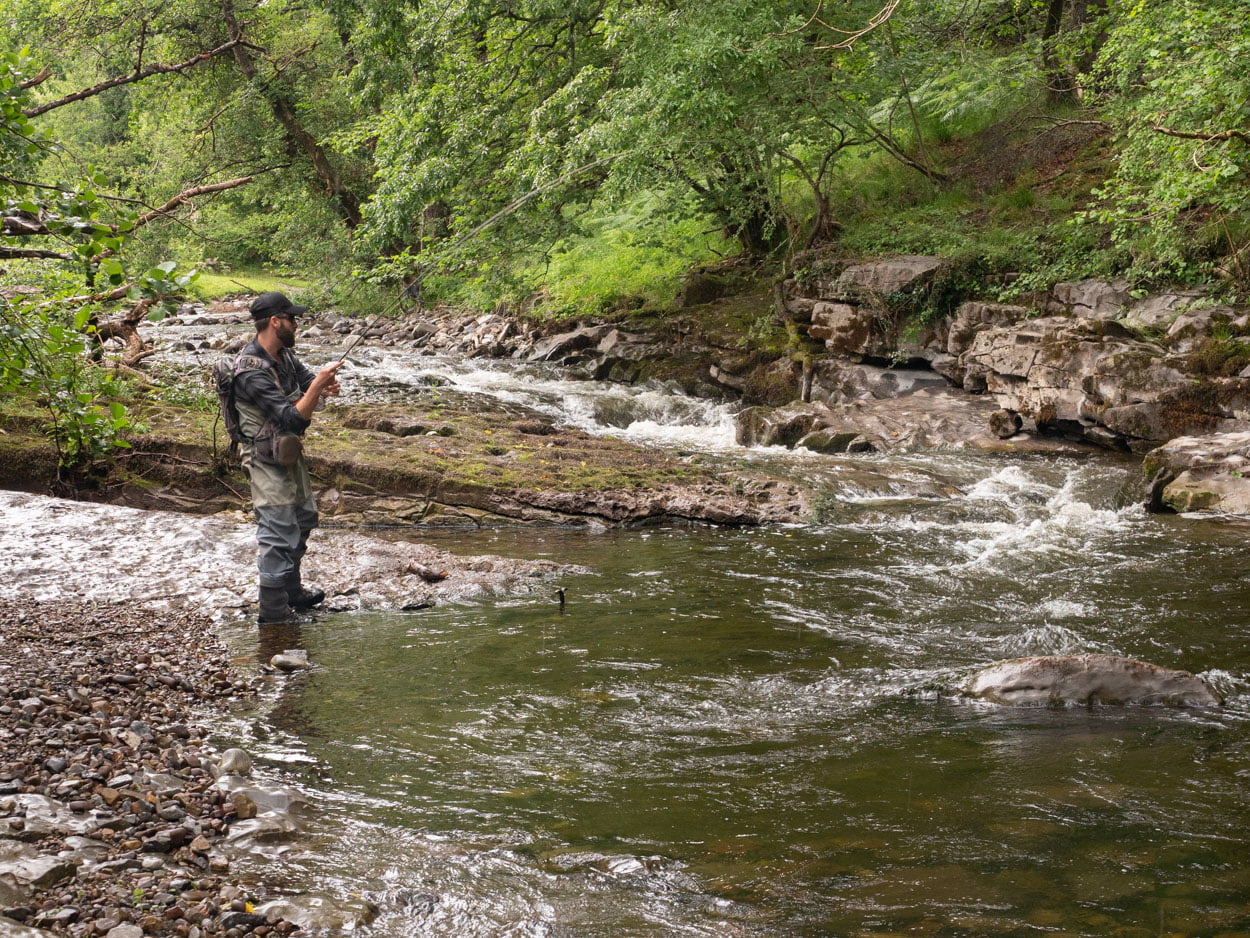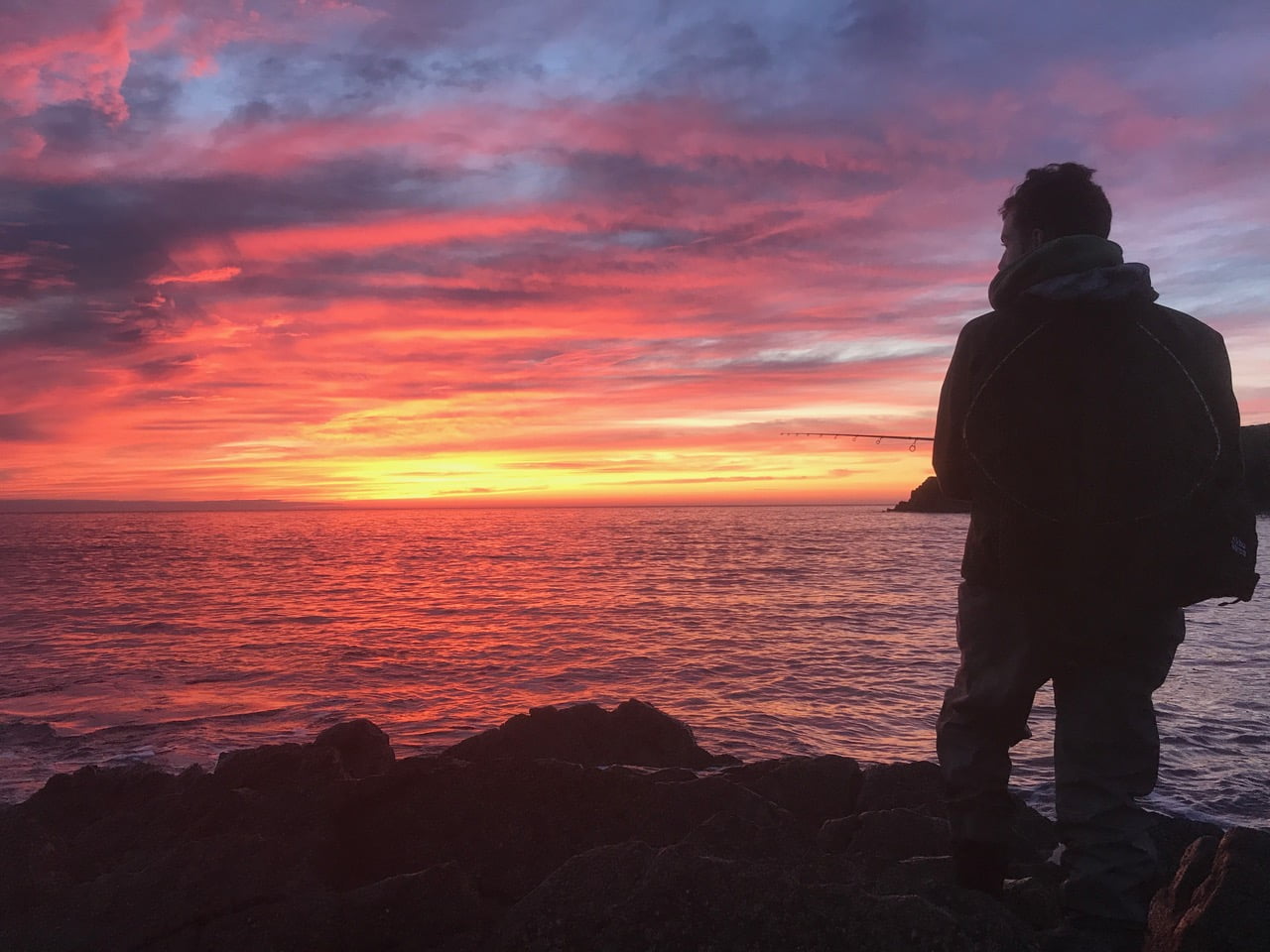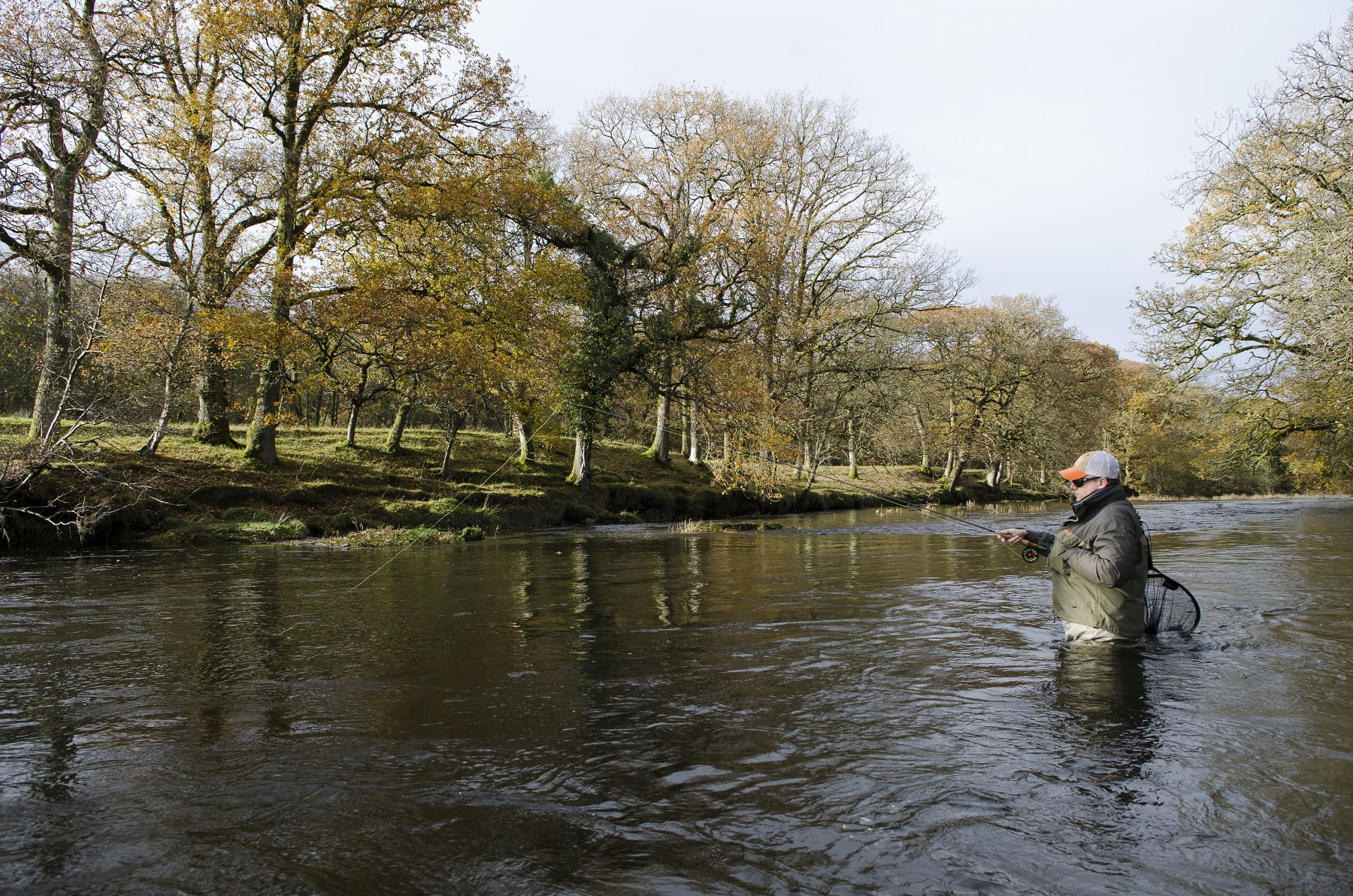Ever fancied fishing your local river for trout? Whether your usual diet is stillwater angling, or you’re a coarse fisher looking to try something new, you’re in for a treat with these river fly fishing tips.
River Fly Fishing for Beginners: 10 Top Tips
Ever fancied fishing your local river for trout? Whether your usual diet is stillwater angling, or you’re a coarse fisher looking to try something new, you’re in for a treat.
In fact, contrary to what you might think, there’s a heck of a lot of water available these days. Much of it is also cheap and lightly fished – and where better to try than in Wales, which has a huge number of rivers and streams that are full of wild trout.

IMAGE: Fishing a Welsh river
So where do you begin? While it’s a different game to stillwater trout fishing, it’s not rocket science to get started on a stream. Here Dom Garnett of the Angling Trust shares ten tips on essential tackle and wild trout technique, before you wade in:
- Where can I find affordable fly fishing in Wales?
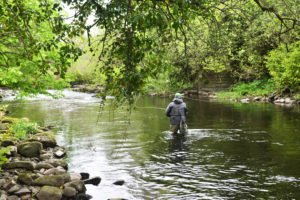
IMAGE: Affordable fishing can be found in Wales
Don’t assume all river fishing is exclusive or expensive. Chalkstream fishing in England can cost a bomb; but in Wales quality river fishing can be cheap as chips. Smaller local clubs in Wales are one excellent source of cheap day ticket options – a full list of club water can be found on Fishing in Wales. Various token and passport schemes are another, including the Wye and Usk Foundation’s Fishing Passport.
- Which fly rods are best for river fishing?
So let’s cut straight to the basics and look at simple tackle for river fly fishing. For small to mid sized rivers, I would go for a short (7ft – 8ft 6”) light trout fly rod with a line weight rating of 3 – 4. This length is ideal for small stream with lots of tree cover or slightly cramped conditions.
For larger rivers, a longer rod has advantages. If it’s relatively open, with bigger glides of water and more space, a 9ft to 10ft rod in a 3, 4 or 5 weight will come in handy. It just gives that little bit of extra reach and control, plus the ability to cast further distances into a headwind if required (a heavier line rating allows you to cast further and into the wind, but presentation wont be as good)
You needn’t spend a fortune. In fact, the Shakespeare Agility range is awesome for the money, starting at less than £60. Alternatively, the are a number of reasonably priced starter kits out there, from Airflo, Greys, Cortland and Shakespeare to name a few brands. Some of these kits start at just £69.99.
- Reels, fly lines and leaders?
Stock up with a few tapered leaders or buy a floating polyleader. Costing less than £3, they’ll help your casting and presentation.
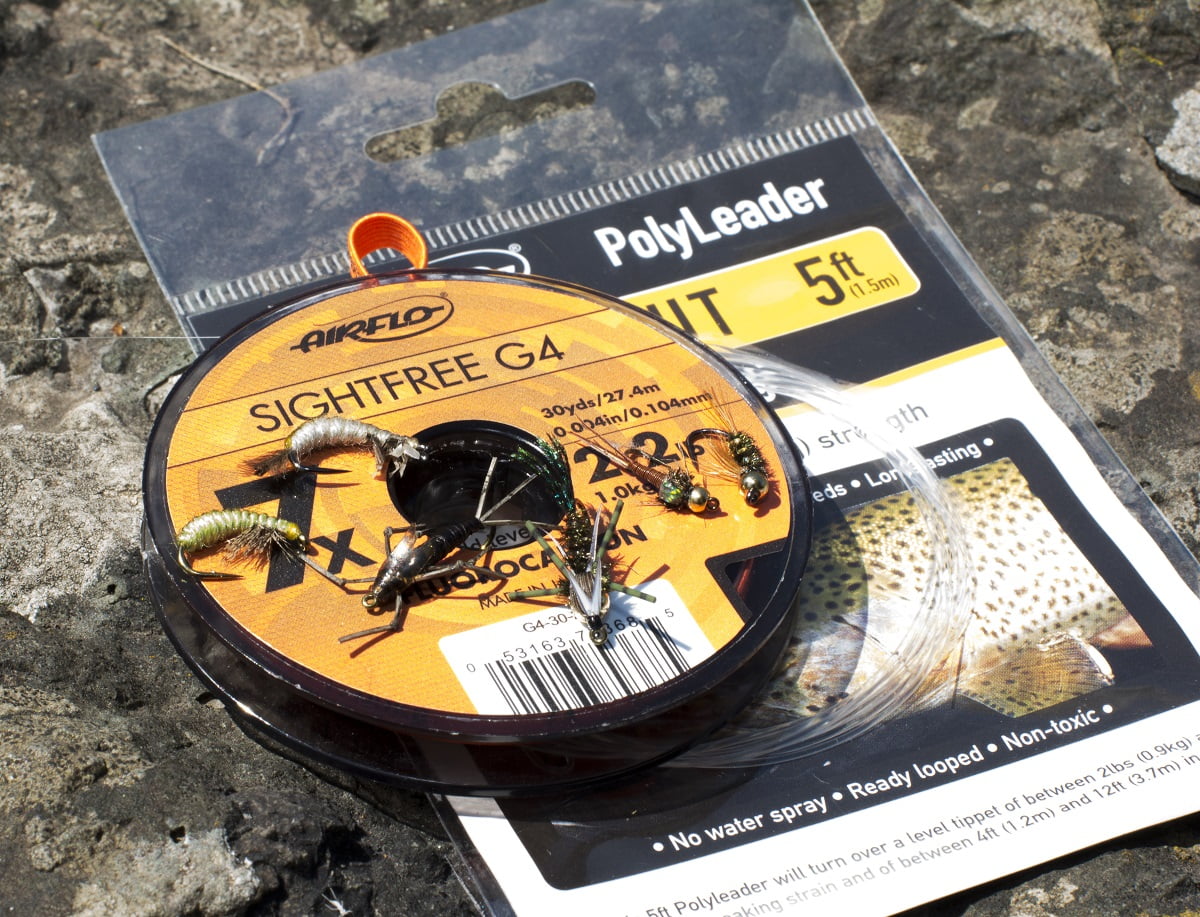
IMAGE: Flies, tippet and leader
A reel with bling is not terribly important, so I’d suggest you choose something that’s good value for money and functional. Cash you save here should be invested in a decent fly line instead. Go for a floating, weight forward fly line to match your rod. Airflo Velocity fly lines are among the most competitive, from only £24.99. If you have a bit more to spend, or you’re looking for ideas to add to your birthday or Christmas wish list, Cortland lines such as the classic 444, or Rio Mainstream are excellent.
Next, you need some leaders. The “leader” is the length of mono that goes between fly line and fly. Tapered leaders (3-4lbs strength) are best for ease of use – designed to help turn the fly over and make your cast land neatly. These tend to come in 9ft lengths, which is ideal to start with. You can use much longer leaders (e.g 12 to 15ft) for shy fish and open water, or indeed a bit shorter for bushy streams, but 9ft is a good start.
You could also get some finer line (say 3lbs or so) to use as “tippet” material. In simple terms, the “tippet” is a couple of feet or so of lighter line that goes between your leader and the fly. Not only is a final section of finer line harder for the trout to spot, it also means that if you get snagged you only lose a little bit of line. You can also use polyleaders – which are usually 5 foot long. These are tapered, and really help with turnover. To the end of the polyleader add 4/5 foot of level tippet.
- Other essentials for river trout fishing
A trout scoop net has ultra fine mesh to protect delicate fins, or in some cases a rubber mesh. Avoid knotted mesh nets, these are damaging for the fish, and in the case of game fish such as sea trout or salmon their use is banned in Wales. Airflo’s Streamtec Pan Net is a good choice for just £12.99, but there are many others, from brands such as Snowbee and Greys, priced between £20 and £30.
There are a handful of other things I wouldn’t be without for river fishing. One is a pair of waders – a must if you want to reach the best spots. Thigh waders are fine for small to medium rivers, but chest waders are the best bet for most rivers in Wales. A simple, functional pair will do just fine.
Another must is a pair of polarising sunglasses, which protect your eyes and make fish spotting easier. Again, you don’t need to spend a bomb (I usually spend about £20 because I’m great at losing and breaking them).
I’d also take two simple products to help your lines and flies float or sink: a tub of Leda Sink and a tub of floatant, such as Gink. There are other brands available that do the same thing.
Finally, I like to use a fly fishing wading vest or chest pack to store odds and ends, because typical fishing bags are a pain when wading and I like to keep my arms as free as possible! You might also grab a portable scoop net to clip to your back.
- Suss out your river
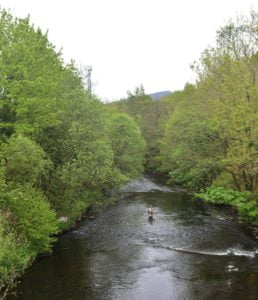
IMAGE: Don’t fear the flow: trout love current and oxygen.
It’s tempting just to find a river and start casting. A better plan is to watch the water for a while and enjoy slowly immersing yourself in the little world that is a trout stream. To start with, smaller rivers and streams are easier than the bigger waters. The fish here can be spooky at close quarters, but it’s much easier to find them and suss out the best places to fish.
See if you can spot rises, fish and anything that’s hatching, along with any features you think might hold fish. Beginners quite often like to fish where the water is slow or even slack, because it’s easier fishing. However, trout prefer the flow. It brings their food to them and provides oxygen rich water. So while they like obstructions like boulders, submerged bushes and other little sheltering spots, they also like to be near the current, where insects that hatch or fall in are carried towards them.
One tip I often share when guiding is to watch bubbles and little bits of debris on the surface of a river. These will take a particular path, like a mini conveyor belt, indicating exactly where the current tends to carry the things trout feed on.
- Be stealthy

IMAGE:Keep a low profile whenever possible
Whether or not your first attempts are successful, river trout will quickly teach you the need for stealth and caution. They tend to be shyer than stocked fish, and the lower and clearer the water the more this is the case. As a rather tall and sometimes clumsy human being, I’ve learned this the hard way! Always wade slowly and carefully, avoiding sudden movements that send out too many ripples. It’s a balance between getting close enough to catch the fish, but not so close they bolt for it.
Beyond obvious things, like not casting a big shadow or stomping about, try wading and casting upstream. Trout will naturally face into the current (upstream), so if you approach them from behind, or from “downstream”, you’ll get closer to them without spooking them.
- Make your casts count
You’ve found a nice looking spot and perhaps even seen a fish. Now comes the moment of truth. If there’s space, you might manage a standard, overhead cast. If it’s cramped, a roll or side cast might be needed. Side casts are especially useful to get your fly line under trees and make the most of limited space.
Another golden rule is to make your cast land as gently as possible. If everything splats down on the water, the trout are likely to spook. Aim as if you were casting just above the water.
Perhaps the most common beginner’s mistake is to have too many casts. Rather than thrashing the water, it’s much better to watch carefully and make just one or two careful deliveries at a time. There’s no rush, and one good cast is worth ten poor shots.
- Get a handle on local hatches
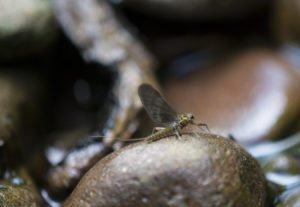
IMAGE: UPWING FLY – Olive upright
Identifying fly life is something that can scare or baffle newcomers to fly fishing. Indeed, read some of the more obsessive articles and you might think you need a doctorate in bug life to catch fish. It isn’t true. In fact a lot of the time, you’ll catch on “general fit” fly patterns if you present them naturally.
Of course, it’s always going to be helpful to get a rough idea of what’s hatching. It’s fun too – and you can do it at your own pace, one or two species at a time. Latin names and pedantic amounts of detail don’t matter – but do try and get a rough idea of the size and colour of what hatches. The Fishing In Wales website features a handy ‘match the hatch guide’ created especially for Welsh rivers – check it out here.
- Stock up with some proven river flies
River fly patterns can quickly get confusing, so keep it simple to begin with. If you’re used to stillwater fishing, you’ll find the flies a lot smaller and more realistic (typically sizes 14 to 18 are best to start with). I would take a simple Klinkhammer Emerger in a few colours (an excellent and easy to spot floating fly), along with the F-Fly and perhaps a few little Caddis. As for nymphs, you cannot go far wrong with a beaded Hare’s Ear and a Pheasant Tail Nymph.
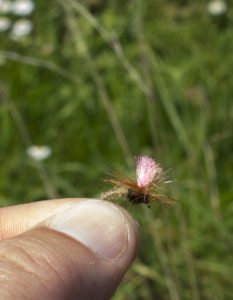
IMAGE: Kilinkhammer emerger
- Simple tactics to catch a fish
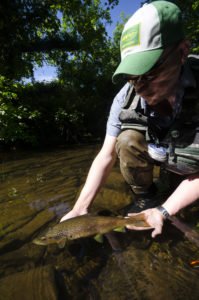
IMAGE: Little beats a day on a trout stream in Wales.
If you can see fish rising now and again, you could start with a dry fly. Watch carefully and try to see where the fish is coming up from (the rings at the surface or “rise forms” will travel with the flow, so the actual trout could be another few feet away). Do the rises keep occurring in the same place?
Much of the art of successful river fishing is sussing how to make your fly look natural. Hence much of the time, the angler will aim for “dead drift” (i.e. letting the fly moving at the exact same speed as the current, just like a real one that was hatching or had fallen in). To get this just right takes practice. You’ll need to watch the current carefully and keep picking up the slack fly line after you’ve cast, so you don’t have yards of the stuff dancing about on the water.
If nothing is rising, or you are struggling to get the fish to take a dry fly, then a sinking nymph is the best way to catch. The easiest way to do this is to use the so-called “New Zealand dropper”. All this means is taking a buoyant dry fly like a Klinkhammer or Caddis, and using this to suspend a sinking fly. All you do is tie a little light mono (say 40cm or so of 3lbs line) to the bend of the dry fly hook, and then attach your nymph to the other end. When the trout takes the sunk fly, the dry fly will pull under. Time to strike!
Hopefully, that first Welsh river trout will be a magical experience to make your rod bend and your heart race. It might be a fish that leads to a slightly lighter wallet and a lot of happily lost hours on running water; but you really can’t put a price on something as delightful as a day on a trout stream.
Tackle up for river fly fishing: Quick checklist – short, light fly rod and reel, A floating, weight forward fly line, 9 ft tapered leaders, fly box with flies, a pair of waders, polarising sunglasses, a fly vest and a scoop net.
We hope these tips help you to approach your local river with confidence and catch that first wild trout. Obviously, there’s a lot to learn, so do take it steady and move at your own pace. Books, articles and lots of practice are sure to help – it’s also well worth keeping an eye on the Fishing In Wales blog, for great articles by a team of experienced anglers from Wales and beyond. And remember, you’ll need a freshwater rod license to enjoy the fun!
For a real head start in fly fishing on rivers, another excellent step is to book a fly fishing guide. With a qualified guide or instructor, you could learn more in a day than you might in many months on your own. Check out this list of guides and instructors that operate in Wales here
Words: Dom Garnett Images: Tim Hughes

